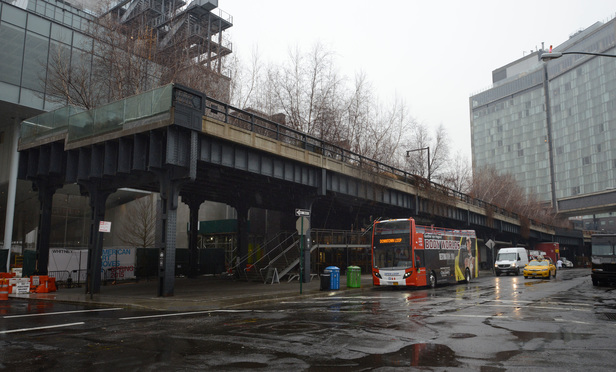The U.S. Supreme Court will not hear the appeal of eight Manhattan property owners who claimed an unconstitutional taking when their lots were rendered less valuable due to the preservation of an elevated railroad track above the lots that eventually became the High Line park.
The high court Monday declined without comment to disturb the ruling of the U.S. Court of Federal Claims in West Chelsea Buildings, LLC v. United States, 109 Fed. Cl. 5, 28 (2013), aff’d, 554 F. App’x 942 (Fed. Cir. 2014).
The case stemmed from the 2005 decision of New York City Mayor Michael Bloomberg to transform the elevated line into a public park under a federal statute allowing conversions of “rails to trails.”
Federal authorities reclaimed the property from the railroad, which originally had been the New York Central Railroad Company, and conveyed it to New York City. West Chelsea and other property owners consented to the High Line and executed covenants not to sue in favor of both the U.S. and New York City.
The developers in their lawsuit, however, asserted they never intended to release the U.S. from a takings claim. They also argued that under New York law, the federal government could not be a third-party beneficiary to such an agreement, and that Supreme Court precedent precludes enforcement of such waivers of constitutional rights to bring takings claims under the Fifth Amendment.
The trial court ruled against them. Court of Federal Claims Judge Nancy Firestone held that the plaintiffs received valuable development rights for granting the covenants not to sue, as well as releases from environmental claims and indemnifications and guarantees regarding the High Line development plans.
Firestone also said the plaintiffs, who were sophisticated property developers, had adequate legal representation when they signed the covenants, and noted they had waited nearly six years after the High Line had been built to bring their claim.
The High Line is a 1.4 mile-long park built on the elevated former rail bed that winds from Gansevoort Street to West 34th Street between 10th and 12th avenues.
According to the plaintiff’s briefs, since the High Line opened in 2009, more than 2,500 new residential units, 1,000 hotel rooms, and 500,000 square feet of new office and art gallery space sprung up in the surrounding neighborhood. Between 2003 and 2011, the value of nearby properties not directly under the park climbed by 103 percent, they said, claiming their properties were stymied by the physical presence of the overhead viaduct and did not appreciate in value.
But, Firestone said, “The express language of the agreements demonstrates the parties’ clear intent that plaintiffs would not sue the United States in connection with the High Line. Under New York law, this clear language conveys third-party beneficiary status on the United States.”
Firestone’s ruling was affirmed without comment by the U.S. Court of Appeals for the Federal Circuit.
This content has been archived. It is available through our partners, LexisNexis® and Bloomberg Law.
To view this content, please continue to their sites.
Not a Lexis Subscriber?
Subscribe Now
Not a Bloomberg Law Subscriber?
Subscribe Now
LexisNexis® and Bloomberg Law are third party online distributors of the broad collection of current and archived versions of ALM's legal news publications. LexisNexis® and Bloomberg Law customers are able to access and use ALM's content, including content from the National Law Journal, The American Lawyer, Legaltech News, The New York Law Journal, and Corporate Counsel, as well as other sources of legal information.
For questions call 1-877-256-2472 or contact us at [email protected]



